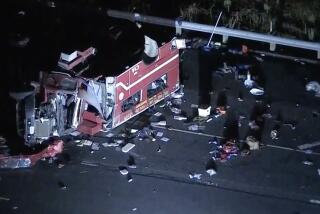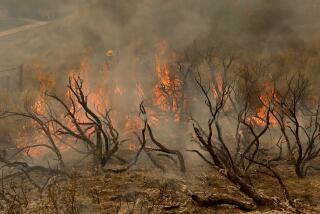Firefighter Battling Forest Fire Is Killed
A firefighter was killed Sunday and six others were injured when the relatively small blaze they were fighting in the rugged Stanislaus National Forest overran the crew, fire officials said.
The seven-member California Department of Forestry and Fire Prevention “helitack” team was among the first to arrive at the blaze along the Tuolumne River.
The team’s helicopter landed about 1 p.m. Less than an hour later, a call came in to the fire’s command center. Firefighters, the caller reported, were down.
The names of the crew members were not released, and the cause of the firefighter’s death had not been determined late Sunday. Forestry department officials said they would hold a news conference to discuss the incident this morning.
Five of those injured were treated for minor burns and smoke inhalation and released from area hospitals, while the sixth remained hospitalized in moderate condition with respiratory problems, officials said.
The blaze was reported at 12:45 p.m. along the Tuolumne River, near the Sweetwater Campground, a popular launch site for rafters. The crew flew from its base in Columbia, near Sonora, to the blaze, 12 miles east of the town of Groveland and in difficult, steep terrain.
“It’s high country,” said Sharon Torrence, a fire information officer for the forestry department. “There’s timber and brush, and it’s very rocky.”
By evening, 150 firefighters, six fire-retardant dropping planes and five helicopters were battling the flames, and more were on their way, officials said.
By late Sunday night, the fire had grown to 500 acres and was moving northeast through an area that includes 10 campgrounds and California 120, the main western entrance to Yosemite National Park.
Rules for fighting forest fires were established in the late 1950s after 11 men were burned to death in San Diego County as they battled a blaze on a steep incline. Since then, firefighters have been taught to follow safety guidelines meant to reduce the chance that a fire takes them by surprise.
But decades of academic study of fire behavior has never removed the mortal danger of fighting fires. In 1994, 14 firefighters wearing fire-resistant clothing and carrying high-tech fire shelters died as a blaze raced up Colorado’s Storm King Mountain.
An abundance of trees, which enables a fire to flit from top to top rapidly, coupled with hilly terrain, dramatically increases the dangers firefighters face, said Shankar Mahalingam, professor of mechanical engineering at UC Riverside.
“Firefighters are trained and they know how to avoid these types of situations,” Mahalingam said, “but sometimes if, for example they are in a canyon, the fire can race ahead and it reaches over the crest of a hill before there is time to react.”
This year, fire officials have warned that this fire season could be as dangerous as last year’s, which is considered the worst in the state’s history. So far this year, state fire officials have reported more than 6,000 forest fires and more than 172,000 acres burned, more than twice as many as the same time last year.
Stanislaus National Forest, where Sunday’s incident occurred, has been under an high fire hazard order since last month, which put temporary restrictions on any open flames. In 1987, the area was the site of one of the largest wildland fires in state history, a fire that burned nearly 146,000 acres and killed a firefighter struck by a falling tree while working to clear brush.
*
Staff writer Lisa Richardson contributed to this report.
More to Read
Sign up for Essential California
The most important California stories and recommendations in your inbox every morning.
You may occasionally receive promotional content from the Los Angeles Times.










